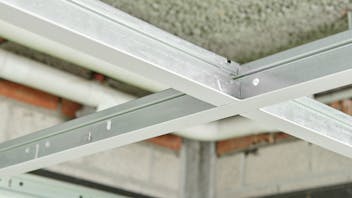Hanging ceiling tiles.
Hanging ceiling tiles made with our stone wool material provides installing contractors with lightweight solutions for ceilings. Our stone wool dropped ceiling tiles are approximate 50 to 80 percent lighter than wet-felted mineral fiber drop ceiling tiles or gypsum hung ceiling panels.
The lighter weight of stone wool ceiling panels simplifies the handling process and movement of material to the job site. It can also help installers avoid back injuries during suspended ceiling tile installation. Installing acoustic drop ceiling tiles or panels made of lightweight stone wool contributes to reduced labor and faster completion times, and saves on total project costs, making stone wool ceiling panels a more economical choice, too.
Further contributing to the speed and value, our stone wool ceiling solutions help to meet your fast-track schedules. Due to the inherent nature of stone wool and the ability to resist water and humidity, Rockfon ceiling tiles can be installed in unfinished buildings where windows are not fully sealed or where HVAC systems are not yet functional. This is ideal for accelerating the construction process, avoiding future delays with interior trades and enhancing peace-of-mind for all.
How to cut ceiling tiles.
The best way to cut stone wool ceiling tiles is in one stroke with your standard utility knife. Contractors familiar with cutting wet-felted mineral fiber or gypsum drop ceiling tiles are familiar with scoring and snapping the panels which can often be a time consuming messy job resulting in rough edges and damaged tiles. A basic, sharp ceiling tile knife and your skill is all you should need to know how to cut acoustic drop ceiling tiles from Rockfon.
Our stone wool products can be cut easily and precisely, without crumbling or using any special ceiling tile cutting tips and tricks. Our ceiling tiles are less brittle and less friable than other materials, therefore making them less prone to damage with on-site handling.
An additional benefit to stone wool ceiling tiles is that no dust is generated from cutting with a knife. This allows for the ceiling tiles to be cut while you’re inside the building – helping to not only avoid multiple trips but also ensure a more accurate fit when cutting drop ceiling tiles to install around walls, irregular outside corners, and integrated services.
To maintain a uniform, overall appearance within the ceiling grid, visible cut edges of the acoustic ceiling tile should be treated with the appropriate Rockfon edge paint.
Because our stone wool ceiling panels are easy to cut and have robust edges, they result in less waste and produce neat, efficient installations.













